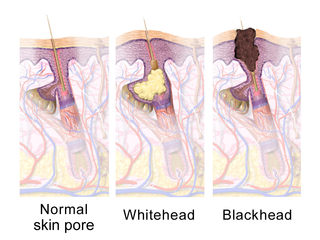
A melanocytic nevus is a type of melanocytic tumor that contains nevus cells.

A port-wine stain, also commonly called a firemark, is a discoloration of the human skin caused by a vascular anomaly. They are so named for their coloration, which is similar in color to port wine, a fortified red wine from Portugal.

Café au lait spots, or café au lait macules, are flat, pigmented birthmarks. The name café au lait is French for "coffee with milk" and refers to their light-brown color. They are also called "giraffe spots," or "coast of Maine spots," which refers to their jagged borders.

A comedo is a clogged hair follicle (pore) in the skin. Keratin combines with oil to block the follicle. A comedo can be open (blackhead) or closed by skin (whitehead) and occur with or without acne. The word comedo comes from the Latin comedere, meaning 'to eat up', and was historically used to describe parasitic worms; in modern medical terminology, it is used to suggest the worm-like appearance of the expressed material.

Blue nevus is a type of melanocytic nevus. The blue colour is caused by the pigment being deeper in the skin than in ordinary nevi. In principle they are harmless but they can sometimes be mimicked by malignant lesions, i.e. some melanomas can look like a blue nevus.

Nevus anemicus is a congenital disorder characterized by macules of varying size and shape that are paler than the surrounding skin and cannot be made red by trauma, cold, or heat. The paler area is due to the blood vessels within the area which are more sensitive to the body’s normal vasoconstricting chemicals.

A connective tissue nevus may be present at birth or appear within the first few years, is elevated, soft to firm, varying from 0.5 to several centimeters in diameter, and may be grouped, linear, or irregularly distributed.
Nevus lipomatosus superficialis is characterized by soft, yellowish papules or cerebriform plaques, usually of the buttock or thigh, less often of the ear or scalp, with a wrinkled rather than warty surface.
Linear and whorled nevoid hypermelanosis is a disorder of pigmentation that develops within a few weeks of birth and progresses for one to two years before stabilizing. There is linear and whorled hyperpigmentation following the lines of Blaschko without preceding bullae or verrucous lesions. It is important to exclude other pigmentary disorders following the Blaschko lines before making a diagnosis of linear and whorled nevoid hypermelanosis. The differential diagnoses include incontinentia pigmenti, linear epidermal nevus, hypomelanosis of Ito and Goltz syndrome. Recently, a case of linear and whorled nevoid hypermelanosis was reported in a Malaysian Chinese girl.

Nevus sebaceus or sebaceous nevus is a congenital, hairless plaque that typically occurs on the face or scalp. Such nevi are present at birth, or early childhood, affecting males and females of all races equally. The condition is named for an overgrowth of sebaceous glands in the area of the nevus.

Linear verrucous epidermal nevus is a skin lesion characterized by a verrucous skin-colored, dirty-gray or brown papule. Generally, multiple papules present simultaneously, and coalesce to form a serpiginous plaque. When this nevus covers a diffuse or extensive portion of the body's surface area, it may be referred to as a systematized epidermal nevus, when it involved only one-half of the body it is called a nevus unius lateris.
Epidermal nevus syndrome is a rare disease that was first described in 1968 and consists of extensive epidermal nevi with abnormalities of the central nervous system (CNS), skeleton, skin, cardiovascular system, genitourinary system and eyes. However, since the syndrome's first description, a broader concept for the "epidermal nevus" syndrome has been proposed, with at least six types being described:
Schimmelpenning syndrome is a neurocutaneous condition characterized by one or more sebaceous nevi, usually appearing on the face or scalp, associated with anomalies of the central nervous system, ocular system, skeletal system, cardiovascular system, and genitourinary system.
Pigmented hairy epidermal nevus syndrome is a cutaneous condition characterized by a Becker nevus, ipsilateral hypoplasia of the breast, and skeletal defects such as scoliosis.
Phakomatosis pigmentokeratotica is a rare neurocutanous condition characterized by the combination of an organoid sebaceous nevus and speckled lentiginous nevus. It is an unusual variant of epidermal naevus syndrome. It was first described by Happle et al. It is often associated with neurological or skeletal anomalies such as hemiatrophy, dysaesthesia and hyperhidrosis in a segmental pattern, mild mental retardation, seizures, deafness, ptosis and strabismus.

Nevus spilus is a skin lesion that presents as a light brown or tan macule, speckled with smaller, darker macules or papules.. Prevalance is around 2%, according to a limited study by Kopf et al
Zosteriform speckled lentiginous nevus is a skin lesion that may be the result of a potentially lethal mutation.











